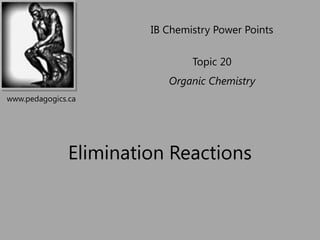Topic 20 3 elimination reactions
•Descargar como PPTX, PDF•
7 recomendaciones•3,810 vistas
Denunciar
Compartir
Denunciar
Compartir

Recomendados
Recomendados
Más contenido relacionado
La actualidad más candente
La actualidad más candente (20)
Heterocyclic compounds - Thiophene - Synthesis of Thiophene - Characteristic ...

Heterocyclic compounds - Thiophene - Synthesis of Thiophene - Characteristic ...
Oxidation of cyclohexanol or preparation of adipic acid

Oxidation of cyclohexanol or preparation of adipic acid
Reduction with metal hydride- PCI syllabus-Organic / Heterocyclic chemistry

Reduction with metal hydride- PCI syllabus-Organic / Heterocyclic chemistry
Factors affecting nucleophilic substitution reactions finished d

Factors affecting nucleophilic substitution reactions finished d
Destacado
Destacado (20)
IB Chemistry on Electrophilic Addition and Synthetic routes

IB Chemistry on Electrophilic Addition and Synthetic routes
Nucleophilic substitution sn1 sn2 nucleophile halogenoalkane in organic chemi...

Nucleophilic substitution sn1 sn2 nucleophile halogenoalkane in organic chemi...
IB Chemistry on Nucleophilic Substitution, SN1, SN2 and protic solvent

IB Chemistry on Nucleophilic Substitution, SN1, SN2 and protic solvent
2011 topic 01 lecture 3 - limiting reactant and percent yield

2011 topic 01 lecture 3 - limiting reactant and percent yield
IB Chemistry on Uncertainty calculation for Order and Rate of reaction

IB Chemistry on Uncertainty calculation for Order and Rate of reaction
IB Chemistry on Mass Spectrometry, Index Hydrogen Deficiency and Isotopes

IB Chemistry on Mass Spectrometry, Index Hydrogen Deficiency and Isotopes
IB Chemistry on HNMR Spectroscopy and Spin spin coupling

IB Chemistry on HNMR Spectroscopy and Spin spin coupling
Similar a Topic 20 3 elimination reactions
Similar a Topic 20 3 elimination reactions (20)
Formation and reaction of carbenes, nitrenes & free radicals

Formation and reaction of carbenes, nitrenes & free radicals
Topic 3 Introduction to Reaction Mechanism (1).pptx

Topic 3 Introduction to Reaction Mechanism (1).pptx
Más de David Young
Más de David Young (20)
2016 topic 0 - oxidation and reduction (INTRODUCTION)

2016 topic 0 - oxidation and reduction (INTRODUCTION)
Topic 20 3 elimination reactions
- 1. IB Chemistry Power Points Topic 20 Organic Chemistry www.pedagogics.ca Elimination Reactions
- 2. Elimination of HBr from halogenoalkanes Recall: nucleophilic substitution of a bromoalkane
- 3. Elimination of HBr from halogenoalkanes Recall: nucleophilic substitution of a bromoalkane
- 4. Elimination of HBr from halogenoalkanes Recall: nucleophilic substitution of a bromoalkane Reaction occurs when bromoethane is added to a dilute NaOH solution. If conditions change, the nature of the reaction will change
- 5. Elimination of HBr from halogenoalkanes An elimination reaction is one where a small molecule is removed from the reactant molecule. Substitution OH- + C2H5Br C2H5OH + Br- Elimination OH- + C2H5Br C2H4 + H2O + Br- Which reaction occurs depends on the reacting conditions.
- 7. Elimination reaction mechanisms E2 mechanism - similar to SN2 - bimolecular process - transition state, no intermediates - typical of primary or secondary substituted alkyl halides
- 9. Elimination reaction mechanisms E1 mechanism - similar to SN1 - unimolecular process - carbocation intermediate - typical of tertiary substituted alkyl halides
- 10. Elimination reaction mechanisms How the reactions happen – the role of OH- The hydroxide ion hits one of the hydrogen atoms in the alkyl halide and pulls it off. ACTS as a BASE! (proton acceptor) This leads to a cascade of electron pair movements resulting in the formation of a carbon-carbon double bond, and the loss of the halogen as R-.
